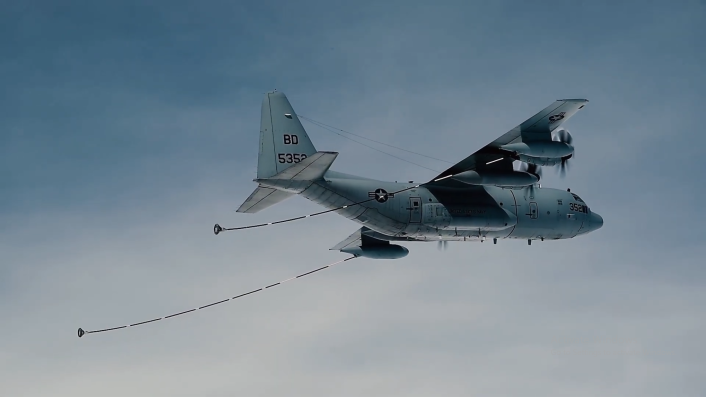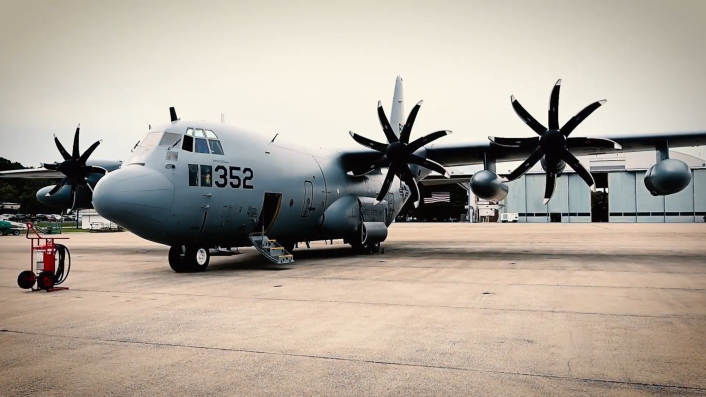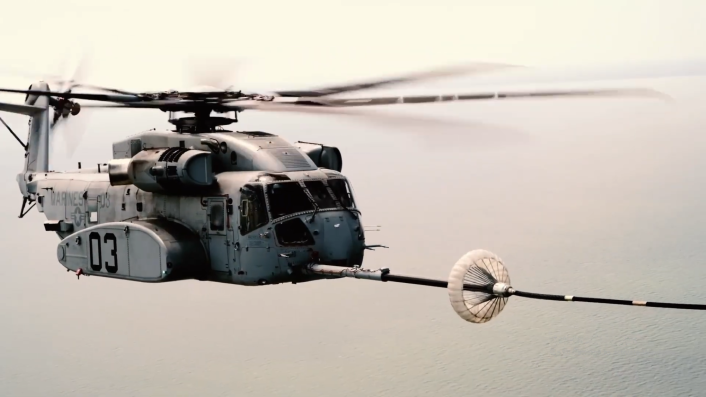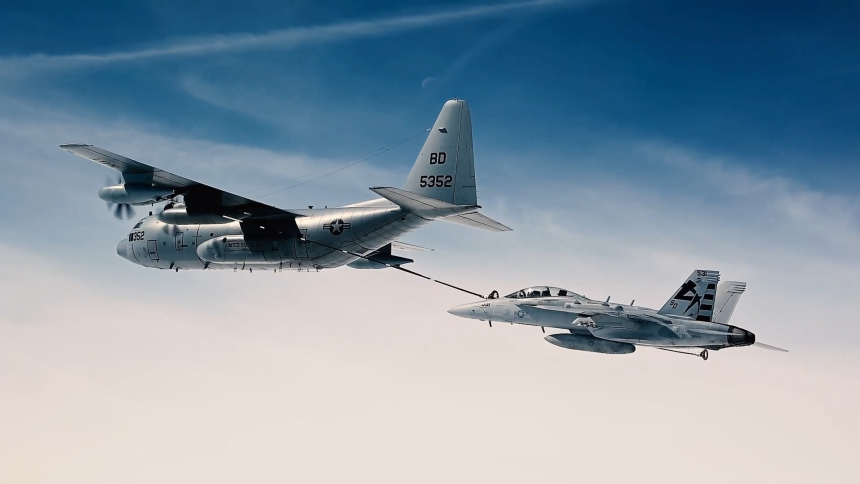Following the adoption of the eight-bladed NP2000 propeller, the U.S. Navy launched an effort to regain the air refueling capability across its fleet and allow the C/KC-130T to refuel a growing number of platforms.
The U.S. Navy’s upgraded legacy KC-130T, which sports new eight-bladed NP-2000 propellers, is being put through testing to expand its aerial refueling envelope and is being certified to serve other aircraft in the Navy’s fleet. In fact, so far only the V-22 Osprey was cleared to be refueled by the upgraded C/KC-130T as it added aerial refueling to its mission sets.
The need to be able to refuel more aircraft types drove the NAWCAD (Naval Air Warfare Center Aircraft Division) to test the C/KC-130T with the CH-53K King Stallion and the EA-18G Growler. It is not clear, however, when the tests took place. Specifically, the testing is focused on verifying how the new propellers and their wake affect the refueling hose and the receiver aircraft.
According to a video released by NAWCAD which included footage of the tests and interviews, the service is collecting data to expand the number of aircraft which can be refueled by the Hercules. These include the F-35C and F-35B used by both the Navy and Marine Corps, the Navy’s E-2C/D Hawkeye AEW&C (Airborne Early Warning and Control) aircraft and the Corps’ legacy F/A-18C/D Hornets.
The effort is led by NAWCAD at Naval Air Station Patuxent River, supported by industry partners, the Air Test and Evaluation Squadron (VX) 20 and Air Test and Evaluation Squadron (VX) 23. The program would help the Navy to employ the legacy C-130T to refuel a growing number of platforms, NAWCAD said in the video narration.
Used by the Naval Reserve, C/KC-130T aircraft “fulfill the Navy Unique Fleet Essential Airlift mission to provide the last logistic mile in support operations to forward deployed Naval Forces,” according to the Navy. The service says it modified most of its four-bladed legacy C/KC-130T aircraft with the NP2000, following a contract awarded to Collins Aerospace in 2018. The U.S. Marine Corps meanwhile divested all of its KC-130Ts in 2021.
NP2000 propellers
The Navy acquired 24 C-130Ts between Jul. 1991 and Dec. 1996, up until recently were exclusively used for cargo missions. Following the propeller upgrade, the Navy began a “process to regain the capability to do aerial refueling across the Navy fleet,” with a first aerial refueling test mission in 2020.

The upgrade effort was spurred after the Air Force and Navy C/KC-130s fleet began to adopt the more efficient eight-bladed NP2000 propeller developed by Collins Aerospace. Collins says that the NP2000’s composite blades and digital Electronic Propeller Control System (EPCS) offer a number of benefits compared to legacy systems, including a 20% thrust increase during take-off, a 20 db sound reduction in the cockpit, and a 50% reduction in maintenance man-hours. The system is also compatible with and already flies on many E-2 Hawkeyes and C-2 Greyhounds, along with the sub-variants of the KC-130 and C-130.
In Sep. 2020, the Air Force contracted Collins to equip 30 Air National Guard and Air Force Reserve C-130Hs with the NP2000 kits. Air and Space Forces said the Air Force also aims to upgrade about 160 of its own C-130Hs with the new propellers. Collins has since then announced additional orders from the Air Force to continue manufacturing the NP2000 propellers.

KC-130T refueling envelope expansion
Capt. Elizabeth Somerville, Commodore of the Naval Test Wing Atlantic, said that even though the V-22 Osprey was cleared to be refueled by NP2000-equipped KC-130Ts, they needed “the rest of the aircraft in the Navy and Marine Corps inventory to be cleared in order to have the flexibility in any future fight.” The Navy’s variant of the Osprey is the CMV-22, while the Marine Corps and the Air Force operate the MV-22B and CV-22B, respectively.
NAWCAD engineers were now tasked with determining “how the new propellers affect the refueling process for the different aircraft in the fleet.” The tests with the EA-18G Growler and the CH 53K King Stallion were focused on this, with the “data collected to be used to expand the number of aircraft that can be refueled by the C/KC-130T.” Maj. Colton Sizemore, the C-130 project supervisor with VX-20, said they tested the impact of the new propellers’ wake and how that affects the hose when deployed for refueling.
Michael Madden, a flight test engineer with VX-23, said that the program progressed relatively fast, and took “less than 6 weeks” from the start to the conclusion of the testing. The U.S. Navy has long been attempting to increase its aerial refuelling capability, with a series of five tests between Oct. and Nov. 2021 seeing the F-35B Lightning II involved in envelope expansion testing with an Air Force KC-46A Pegasus. This also automatically qualified the F-35C to be refuelled by the KC-46A.

To further expand its refueling capabilities, the service is also testing the Boeing MQ-25 Stingray drone, with the first such refueling from the unmanned aircraft to a manned F/A-18E/F Super Hornet fighter taking place on Jun. 4, 2021. The MQ-25 is expected to start flying soon with the Navy and replace the Super Hornet in the tanker role as part of the Carrier Air Wing.









